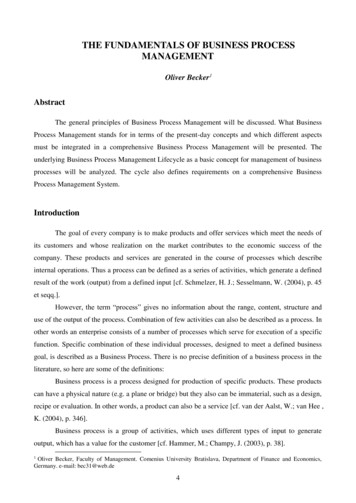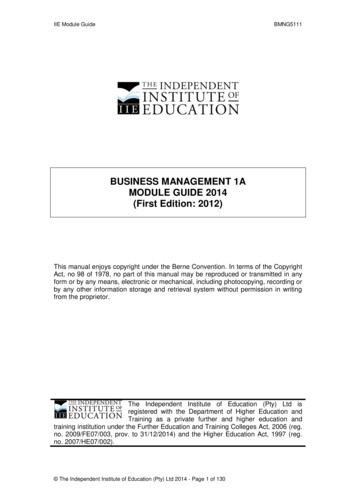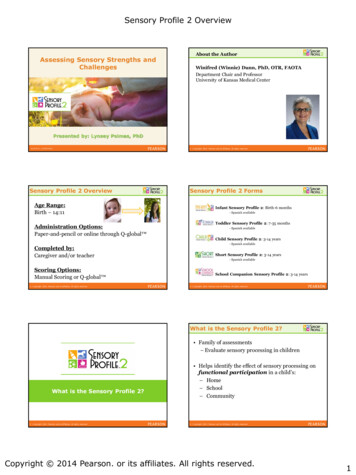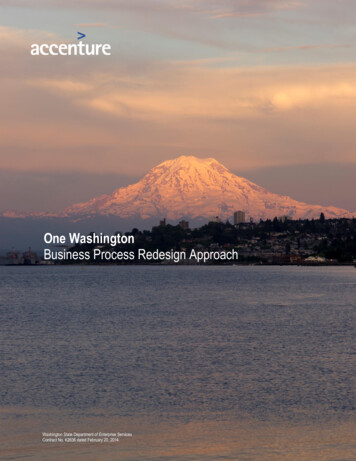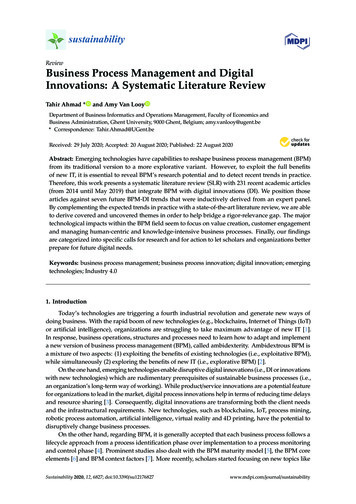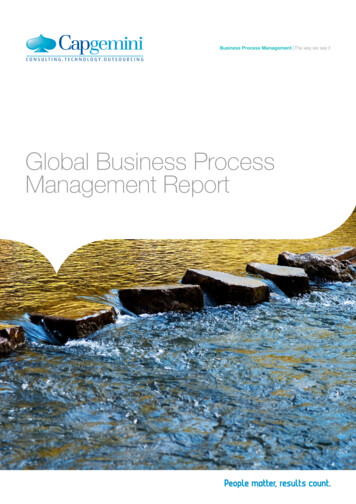
Transcription
Business Process Management The way we see itGlobal Business ProcessManagement Report
Contents2Foreword3About the study4Executive summary6The key to BPM success: BPM as a C-level concern8How may I help you? The key benefits of BPM10Cost efficiencyBusiness agilityComplianceCustomer-centricitySocial media strategyStaff satisfaction101214151920Show me the money: BPM and Return on Investment21Speculating to accumulate: BPM as a counter-cyclical investment23Barriers to BPM implementation25Key conclusions and recommendations29Capgemini sector and country focus32Financial servicesPublic sectorManufacturing, automotive and life sciencesConsumer products and retailTelecommunications, media and entertainment3336384042United KingdomUnited StatesAustraliaGermanyItalyFranceSpainNordic s54
ForewordWelcome to the Capgemini GlobalBusiness Process Management(BPM) Report. This report is anexploration of key trends in BPM asseen by CXOs across a broad selectionof sectors and geographies. BPMis perhaps at a tipping point – it’scertainly at an exciting stage in itsevolution. As both an engineer andan Operational Research practitionerin my early career, and subsequentlyas a consultant, I have seen BPMthrough its development over thelast 26 years. BPM has its roots inmanagement practices such as TotalQuality Management, BusinessProcess Reengineering & Model BasedDevelopment; but the advent of the newgeneration of sophisticated modellingand process execution technologieshas greatly enhanced BPM’s powerto truly transform businesses. Thishas created one of the most rapidlygrowing and attractive market sectorsfor both services and technology. Wesee BPM as a critical managementdiscipline that when executed againstclear, cross organizational businessobjectives, can deliver exceptionalvalue to that organization. However,we also see that the potential for BPMis not well understood. Our decision toconduct this global survey was drivenby our discussions with our clients,to understand their current position,their understanding, how its valuewas measured, how it is used andprioritized within their Business andTechnology Transformation efforts.This research confirms our beliefthat BPM needs to be a jointly ownedBusiness and IT discipline. It alsodemonstrates that it is starting to gainsignificant traction in the marketand investments are starting to paydividends to the early adopters. AtCapgemini we are being asked byour clients to help them simplifyand improve their business modelsand the technology that supportsthem and we are already seeing3BPM become an integral andkey part of this proposition.Business Process Management isbecoming ever more relevant to bothlarge and small organizations in thecurrent economic climate. At a timewhen many different market sectors arefacing slow revenue growth, customerchurn and increased pressureson costs, BPM becomes a criticalweapon in the battle for efficiencyand effectiveness in processes.Furthermore, in a challenging andchanging business environmentthat is characterized by uncertainty,it allows organizations to adapt, bemore agile and fleet of foot. Capgeminiare seeing strong demand for BPMservices in markets such as USA,UK, the Netherlands and France;and there are clear signs of increasedinterest in other geographies such as,Germany, Sweden, Spain, Italy andAustralia. In sector terms, the financialservices industry has led the way inBPM adoption over the recent past,driven by increased focus on customercentricity and regulatory compliance.Other sectors, public sector, utilities,telco, retail and manufacturing are nownot only catching up, but are startingto use BPM in new ways to create newbusiness models to serve customersand outsmart the competition.The research findings also showhowever that this is a complexlandscape, and we are not seeingadoption of BPM in a clear andconsistent way. This report also looksat some of the barriers to adoption,with organizational silos being amajor obstacle. Waters are furthermuddied by fragmented budgets, lackof clear governance and ownershipand internal politics. The objectiveof our investment in this researchproject was to shed some light onthese elements with a view to assistingorganizations to create strategies thatavoid or at least mitigate some of thesebarriers to success. Managementof change in such endeavours is akey part in enabling the appropriatealignment of business and technologyto support their transformationefforts. I hope that you find this reportof benefit in the further adoption ofBusiness Process Management.Bob ScottSenior Vice PresidentGlobal Head of BPMCapgemini
About the studyCapgemini worked with FreshMinds,a UK-based research firm, to conductthe primary research for this study.The research process consisted oftwo complementary phases.During the initial quantitative phaseof the research, a 30 minute onlinesurvey was completed by over 1,100CXOs, senior business managers, ITdirectors and managers, and othersenior business decision-makers.All major industries wererepresented in the study:Only participants from firms withmore than 1,000 employees wereeligible for the survey. 55% of surveyparticipants were drawn fromenterprise companies with 10,000 employees, 16% from large companieswith 5,001-10,000 employees and29% from mid-size companieswith 1,001-5,000 employees.Respondents were drawn quiteevenly from 11 markets: Australia Brazil France Germany Distribution and transport Financial services Public sector India Manufacturing, automotiveand life sciences Netherlands Education and science Italy Consumer products and retail Spain Telecommunications, mediaand entertainment Nordic Region UK Utilities, energy and chemicals USA Professional services Healthcare4The second, qualitative phase of theresearch comprised a series of in-depthqualitative interviews with seniorbusiness and IT professionals drawnfrom the networks of both Capgeminiand FreshMinds Research. Theseindividuals were selected to representa cross-section of geographies andsectors, and were selected for theirpractical experience of BusinessProcess Management initiatives.In each section of the report, ourinsights are based on the quantitativefindings from the primary research,illustrated by graphical representationsof the data. These are supported andillustrated by anecdotal findingsand quotations from the qualitativeinterviews that comprised thesecondary phase of the research. In thesections labelled ‘Capgemini view’ wehave added supplementary analysisthat is drawn from our consultants’experience of working on BPM projects.
5
Global Business ProcessManagement ReportExecutive SummaryCapgemini’s Business Process Management research examinescurrent practice in BPM, the benefits being achieved and thebarriers to success. A key theme is the relationship betweenexecutive-level sponsorship of BPM and its success.The purpose of our research is tohelp organizations understand whatis involved in realizing the benefitsof BPM, and avoid the pitfalls thatmany have already encountered.BPM has an increasingly high profile,with a growing belief among largeorganizations that BPM shouldbe sponsored at a senior level. Ofsurvey respondents who have bothknowledge and practical experienceof the topic, 82% believe that BPMshould be treated as a C-level concern.say that their business processes areeither “managed” or “optimized” thetop two levels of process maturityas defined by our maturity model.There is a correlation between processmaturity and treating BPM as a C-leveltopic. 68% of survey respondentswho state that BPM is an importantagenda item at managerial level alsoThe Capability Maturity Model provides a framework for understanding where our clients fit in terms of their adoption of BPM, and thepotential roadmap for further development. The model was first developed by the Software Engineering Institute of Carnegie MellonUniversity. 1RepeatableManagedThe processis at leastdocumentedsufficientlyThe processis deliberatelymanaged inaccordance withagreed uponmetricsThe startingpoint for useof a new orundocumentedrepeat processThe processis defined /confirmedas a liberate processoptimization kipedia.org/wiki/Capability Maturity Model
Figure 1. There is a clear correlation between prioritization of BPM adoption within abusiness and improved performance of processes.Which of the following best describes the level of process maturity within your organization?Total6.8%1.7%InitialRespondents who indicated “Currently Business ProcessManagement is an important agenda item at managerial level”15.9% 11.4%27.3% 18.8%23.6% 38.9%15.8% 28.8%10.7% 0.4%RepeatableDefinedManagedOptimizingDon’t knowThe research highlightedpractical issues which must beovercome in order to implementBPM successfully, notably: Functional silo culture Fragmented budget Perception of BPM as an IT matter Resistance to BPM from ITstaff who have responsibilityfor existing systems A lack of readiness orwillingness to tackle the changemanagement issues associatedwith BPM implementationsTo overcome these barriers, strongleadership (including C-levelinvolvement) plus a clear vision areneeded. Another requirement forsuccessful BPM implementation is thatcompanies must be willing to breakwith the past and embrace change.Overall, just 16% of respondentsbelieve that their organization’sprocesses are currently at the“optimized” level, but more than everbefore, companies are recognizingthe opportunity that BPM presentsto improve process maturity. 45% ofparticipants in the survey anticipatedthat their organization’s interest inBPM would increase over the next 12months. This finding confirms thatBPM is increasingly becoming a part ofmainstream management thinking.customers reported a positive impacton the business. A similar proportion ofthose whose objective was to improvecompliance and risk managementobserved a beneficial impact. Specificbenefits of BPM adoption which camethrough strongly were improved staffsatisfaction and greater efficiency.There is compelling evidence thatBPM can deliver tangible businessvalue. 96% of those who had triedto measure ROI from their BPMinvestment reported a positive return,with 55% measuring a return of atleast twice their initial investment.This may explain the finding thatin challenging economic times,investment in BPM becomes more,rather than less, attractive. 68% ofrespondents stated that a more difficultbusiness outlook than expectedwould lead to their organizationplacing increased emphasis on BPM.Figure 2. 45% of respondents anticipated that their organizations interest in BPM wouldincrease in the next 12 months.The benefits of BPM vary dependingon the organization’s objectives, aswell as its level of maturity. More thanthree-quarters of those respondentswho had introduced a BPM initiativewith a view to improving relations with7Positioning an organization forBPM requires some effort, but thepositive experiences of those whoparticipated in the research suggestthat it is a step worth taking.How do you anticipate that the current level of interest in BPM within your organization willchange over the next year?13.8%Don’t knowThe same amountof emphasisA lot moreemphasisA little moreemphasis19.9%28.0%3.0%30.8%4.6%A little lessemphasisA lot lessemphasis
The key to BPM success:BPM as a C-level concernThe more Executives know about BPM, the more likely they areto believe that it should be regarded as a C-level concern. 82% ofparticipants who have both knowledge and practical experience ofthe topic believe it should be part of high level business strategy.This is in stark contrast to the 20%of respondents who say that BPM iscurrently treated as an importantagenda item at managerial level withintheir organization. At present, a lackof senior sponsorship means thatonly a minority of companies arereaping the full benefits that BusinessProcess Management can bring. Thesebenefits are discussed in greater detailin the next section of the report.Capgemini viewTo be successful, BPM needs toaddress organizational silos. Inorder to allow this to happen,executive sponsorship at enterpriselevel is essential. It is importantfor C-level decision-makers tofocus on the business outcomesof BPM rather than beinghampered by the existingtechnologies. Strong BPMleadership at a strategic andtactical level is essential forlong-term BPM success.It should be noted that whilestrong BPM leadership isimportant, it is not sufficient.Programs often fail because of alack of day-to-day governance.This can lead to an insufficientframework to address competingrequests for limited resources,differing objectives and timescales.Figure 3. Respondents who have the greatest knowledge of BPM are significantly more likelyto believe it should be treated as a C-level concern.Do you consider BPM to be a C-level concern?“Percentage of respondents indicating ‘Yes’”82.0%60.6%Respondents indicating “I know a lotabout Business Process Management andhave plenty of practical experience of it”8Total Respondents
“Improving process is vital forour business but can be a painfulprocess which meets resistancein some quarters, hence theneed for C-level sponsorship.”IT Manager, enterprise levelutilities business, UK“Process improvements needto be embedded throughoutthe organization. The topmanagement’s time andattention needs to be given tosuch a strategic and longerterm value creating item.”Business Unit Manager,Federal government agency, USAFigure 4. Just 20% of respondents stated that BPM is currently an important agenda item atmanagerial level.Which of the following best describes the current level of interest in Business ProcessManagement within your organization?Ourorganization isnot currentlyinterested inthe topic10.5%We are investigatingthe concept andsmall projects havebeen startedCurrently BusinessProcess Managementis an
The Capability Maturity Model provides a framework for understanding where our clients fit in terms of their adoption of BPM, and the potential roadmap for further development. The model was first developed by the Software Engineering Institute of Carnegie Mellon University. 1 1 odel
